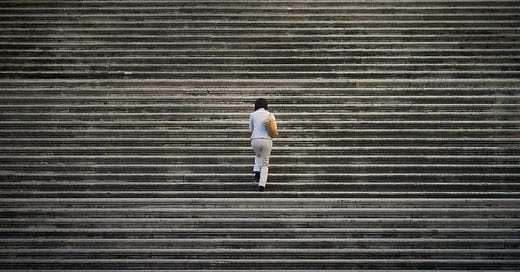Research proves just how effective a single staircase can be.
You’ll learn: Findings from a fascinating study on how climbing stairs can impact your VO2; how to mimic the study protocol for significant benefits.
Quick Announcement: Misogi Event
I’m hosting an epic Misogi retreat in Costa Rica with GORUCK.
Dates: January 22-26, 2024
Location: Botanika Resort, Osa Peninsula, Costa Rica, an incredible five-star resort in the most biologically intense place on earth.
This event will be a deep dive into the art and science of breaking new boundaries in the body and mind. We’ll spend two days training, having fun, and covering the pillars of physical and mental fitness and why Misogi matters. Day three we’ll do a group Misogi.
Yes, this event is within your capabilities. No, you won’t always believe it is when we’re out on our Misogi. Experiencing the gap between your abilities and beliefs is where the magic happens.
Someone asked if there will be yelling. I.e., “will a drill instructor yell at me?” No. Big no. This is not a military-style event. It’s a deep physical and psychological dive—introspection via effort and analysis.
P.S., if you want to bring someone along who skips the Misogi and instead hangs out at the pool, that’s totally cool. We have an add on for that.
Onto today’s post …
If you don’t know why we call this project 2%, here’s why:
2: That’s the percentage of people who take the stairs when an escalator is also available.
But being a 2-Percenter who takes the stairs and every other opportunity to do the slightly harder thing is one of the ultimate health hacks. Taking the stairs is a metaphor for living longer and better.
Yet I sometimes get pushback on this idea. People are skeptical that a few stair climbs a few times a week can do any good.
But a recent study from researchers in Canada shows that every effort counts. Every one.
Why most people don’t take the stairs
The reason 98 percent of people take the escalator is simple: It’s easier. Humans evolved to do the more comfortable thing.
Up until roughly 1950, it made sense to always do the physically easier thing.
You didn’t want to burn extra energy because energy from food was at a premium. You were likely working some physically demanding job all day to survive—and burning calories for the sake of it was potentially dangerous.
This is still the case in some developing countries. Many remote subsistence tribes don’t even have a word for “training” or “exercise.”
Then technological advances allowed us to engineer physical effort out of our days at scale. We got escalators, elevators, tractors, automobiles, industrial manufacturing, desk jobs, and on and on and on. You get the point.
Our environment and jobs suddenly required less physical effort. But we still defaulted to the easy thing.
Physical fitness plummeted. For example, World War II-era US military recruits, on average, performed better on a physical fitness test than modern recruits.
Today only ~15 percent of people in developed countries meet the basic physical activity guidelines.
Why fitness matters and what holds us back
Those scientists in Canada wrote:
“(our lack of physical fitness) has greater consequences than hypertension, smoking, obesity, and hyperlipidemia in terms of risk for adverse health outcomes.”
The most common excuses for why we don’t exercise, according to the scientists, are a “perceived ‘lack of time’ and lack of access to specialized facilities.”
So they wanted to know if there was something people could do that would improve their fitness yet was so quick and accessible that you’d be a fool to avoid it. This “something” wouldn’t require you to:
Change into special workout clothes.
Visit a gym.
Have special fitness equipment.
Take a shower after doing it.
What the scientists did
They took 31 women who were healthy but sedentary. This meant the women got less than one hour of weekly physical activity.
They brought the women into the lab and measured their VO2 max, a metric of cardiovascular fitness that strongly correlates to health outcomes. I.e., Higher VO2 max = farther away from death and disease.
Then, stairs …
The stair workout that isn’t a workout
Because people often say time and equipment are major impediments to being more physically active, the scientists had the women do a routine that anyone with a staircase at home (or who encounters a staircase anywhere) can do.




